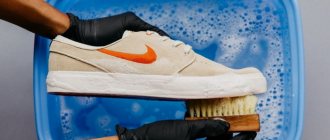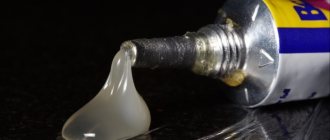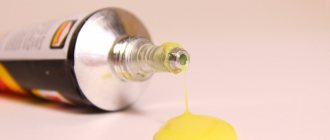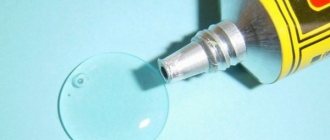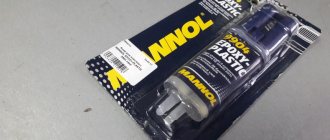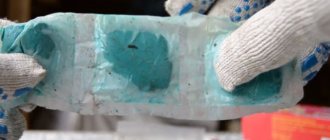If you know the intricacies of the work, then plexiglass lends itself perfectly to gluing. These qualities allow you to model any simple designs from transparent material. And even if individual parts break down, you can easily repair the necessary elements. Learn how to properly glue plexiglass and acrylic, which solution to choose and how to make glue yourself in the article.
How to glue plexiglass
For general understanding, the general principle of mechanical processing of plexiglass looks like this. For example, a jigsaw (hacksaw).
Algorithm:
- The stroke function should be set to zero for slabs up to 4mm.
- Medium feed (1st or 2nd stroke) for thicker slabs.
- Saw at high cutting speed (rpm).
- For a circular saw, the speed is 4200 rpm with a blade diameter of 320 mm.
- Only non-offset (!) discs with teeth from 9 to 15 mm.
- Full start-up before cutting begins.
- A tight installation on a protective film (or an aqueous PVAL solution) is required and cannot be removed.
- It is necessary to cool with water or compressed air. It is unacceptable (!) to cut a slab thicker than 3 mm without cooling.
- Carbide saw (disc) or diamond coated.
Anyone can glue plexiglass together. You don't need any practical experience to do this. It is enough to perform a series of actions in a certain sequence.
Step-by-step instruction:
- Wear gloves to avoid leaving greasy marks on the gluing area. Treat the parts to be glued with a cloth soaked in gasoline or alcohol.
- Fasten both parts of the product symmetrically and so that there is a small gap between them.
- Prepare a medical syringe. The needle must be processed with a file to cut the bevel. Its absence will prevent splashing of the adhesive during operation.
- Fill the syringe with glue. Apply an even layer over the gluing area.
- Press the plexiglass pieces together. Leave them in the fixed position for 1 hour.
Masking tape is used to protect the edges of the parts. Gluing of individual elements should take place in a well-ventilated area. After all work, wash off the dirt with clean water or with the addition of a mild cleaning agent. Wipe dry only after all microparticles have been completely removed.
How to glue plexiglass to metal
Often home craftsmen do not know how to glue plexiglass to metal. To do this, you can use several adhesives:
- Dichloroethane.
- Glue 88.
- Liquid Nails.
Sometimes compounds appear on the shelves of construction stores that indicate that they can be used to glue plexiglass to metal.
Plexiglas to wood
Again, not many people know how to glue plexiglass to wood. When choosing an adhesive to join two different materials, you need to understand that the wrong choice will lead to the formation of a visible seam.
The best adhesives include:
- MAFIX.
- Super glue.
- Cosmofen.
It is advisable to try experimentally gluing unnecessary parts together to see the quality of the connection.
Plexiglas to glass
It is extremely difficult to glue plexiglass to glass. Most often, the compound gains fragility in its properties. Experts recommend using the following formulations:
- COSMOPLAST 500.
- COSMOFEN.
- COSMOFEN PMMA.
These adhesives are very unstable to sudden temperature changes. It is problematic to glue surfaces that tend to heat up during use.
Adhesive self-adhesive films
Plexiglas glue is reliable, but not the safest - most formulations include toxic substances that will not harm a healthy person, but the condition of a small child or a sick individual will worsen.
Self-adhesive double-sided tapes come to the rescue, the key advantage of which is the versatility of the materials being combined, and the main disadvantage is that such a tape is not difficult to see through a transparent surface.
There are three varieties on the market with different features:
- Backless film is a tape with a thickness of less than a millimeter, suitable for merging smooth surfaces. It is practically invisible, but using it with rough or porous objects can result in a loss of time and nerves. But if you comply with all the conditions and do not heat the resulting product, the instrument will serve you happily for a long time;
- Colorless film is a thinner material, inferior in strength, but superior in invisibility to the version without a base. A distinctive feature is the ability to peel off the adhesive strip so that no traces remain;
- Film with an all-foam base - the thickness of the product reaches several millimeters, but this is the best option for uneven or rough surfaces. Porous planes will also be glued together, but not without proper efficiency.
We come across vinegar more often in everyday life.
Plexiglas
A food solution of 9 percent vinegar will not help here. You need vinegar essence. And she will not be able to completely dissolve plexiglass. Using 70 percent of the essence you can only slightly soften the surface of the glass. Usually this is enough for gluing two flat surfaces. In this case, the parts to be glued must be pressed against each other with force.
In this way, plexiglass can be glued using the “cold welding” method, when both surfaces being joined are subjected to dissolution, which creates a strong, uniform seam.
If acid or glue is used, other surfaces may be damaged. They produce 3 types of adhesive films, slightly different in their operating principle. Baseless adhesive films are simply a layer of adhesive sandwiched between two transport layers that are removed when used. This material is suitable for gluing two perfectly flat surfaces, with a small expansion coefficient, that is, it is excellent for parts made of plexiglass.
They are followed by a film with a transparent, very thin base. Its presence slightly reduces the requirement for the smoothness of the bonded surfaces, but they still must be smooth. The connection turns out to be less strong; if desired, the elements can be separated in the future.
If you need to glue two uneven surfaces, a film on a thin foam base is suitable. It gives the lowest degree of gluing and if, as a result, the resulting seam must be subject to stress, it is better not to use it.
Bonding plexiglass is essentially no different from bonding plastic parts using a similar method: you need to use glue that dissolves the surfaces and forms a monolithic seam. In this case, even if the product is destroyed, most likely it will break not along the glue line.
One of the most used adhesives at the moment is Artfix. Transparent, less toxic than analogues, easy to use, it is great for gluing any plexiglass parts. The manufacturer allows you to select glue with the required degree of viscosity.
However, it comes in a fairly large volume. It is not rational to buy it for one-time work.
Security measures
A high content of chemicals can become dangerous for people: firstly, opening the tube each time provokes a slight evaporation that can harm people with a vulnerable sense of smell - to minimize the risk you need to work in a ventilated area; secondly, contact of liquid with the skin can leave a burn or cause poisoning of the body - the solution is to wear gloves and a long-sleeve T-shirt before gluing the plexiglass.
Of course, not every person is susceptible to suffering from contact with glue, but not everyone knows in advance the limits of their body’s capabilities.
It is also recommended to protect your desktop by covering it with a tablecloth or film that you won’t mind throwing away. During free time from needlework, chemical compounds should be stored out of the reach of children and in a place protected from the sun. Products that have expired are prohibited from use.
Gluing acrylic
How to bend plexiglass?
Recommendations on how to glue plexiglass at home will help you get a high-quality, invisible, reliable and durable seam:
- Using a cloth soaked in gasoline, thoroughly degrease the surfaces to be bonded.
- Apply adhesive to both areas to be joined. It is more convenient to do this with a medical syringe - fill it with glue, after grinding the tip off with a block at an angle of 90 degrees. Stitching is necessary to prevent the composition from splashing towards the bevel of the needle. Very carefully pour glue into the joint between the parts that are slightly pressed together and securely fixed.
- Press the surfaces firmly together and maintain firm compression until the compound sets, this may take from 2 minutes to half an hour, depending on the amount of glue poured. The main thing is that the product must dry and not spread over the surface after you turn the product over.
In some cases, it becomes necessary to glue plexiglass to metal or wood.
For a high-quality connection of a metal part and plexiglass, the following are suitable:
- glue grade 88;
- dichloroethane;
- "Liquid Nails";
- glue “Moment for iron and plexiglass”.
When gluing plexiglass to wood, it is important to obtain not only a strong seam, but also an invisible one, since otherwise the attractiveness of the product will be lost. For this reason, the choice of glue must be taken as seriously as possible.
For gluing wooden parts with plexiglass, the following are suitable:
- "Super glue";
- MAFIX adhesives;
- "Cosmofen".
Sequencing:
- Apply glue to the fastening area. Solvent-based solutions are spread over the surface until the top layer begins to melt.
- The parts are pressed tightly against each other and held for 2–4 minutes.
- Fill the joints with a thin layer of adhesive (this will make the seam stronger).
Wait for final adhesion (at least a day).
We figured out how to glue plexiglass, but how to do it correctly? If you have chosen a good glue or solvent, the matter remains small.
- Remove the gloss with sandpaper and degrease the surface.
- If you are afraid that the glue will ruin the glass, cover everything except the joint area with film.
- Apply solvent to both parts. When the plastic softens, connect them and fix until they set. Leave until completely dry.
- Or glue the elements together using factory glue or a homemade composition based on shavings and fix until completely dry.
- Or connect the parts using a quick-setting solvent, secure them and fill the seam with glue using a syringe.
That’s basically it: there are quite a few products and substances that can help you in this matter, as you can see, so a little patience - and everything will definitely work out!
How to make your own adhesive
A means for gluing plexiglass can be made at home. To do this you will need acetone, dichloroethane and crushed plexiglass. In a glass/ceramic container, mix the liquids in a ratio of 1:2 (acetone:dichloroethane). To stir, you will need a glass rod or twisted wire.
See also
Composition and technical characteristics of CMC glue, instructions for use
A piece of polymer is crushed and added to the solution, stirring constantly. The viscosity of homemade glue is determined by eye, depending on the purpose. After the composition has acquired the desired fluidity and becomes transparent, it is left for several hours for final dissolution. The product should be stored in a container with a tight-fitting lid.
A mixture obtained from solvent 646 and polystyrene foam has adhesive properties. Before use, the solutions are mixed again.
Fighting scratches on plexiglass
How to cut plexiglass at home
Even deep scratches on polycarbonate can be repaired. This will help:
- Two types of sandpaper: 800 and 1500 grit.
- Polish, GOI paste is excellent.
- Natural polishing material.
We clean a sheet of polymer plastic that has been previously washed with a mild detergent and moistened with water using 800-grit sandpaper; this will help get rid of large scratches. Then we sand it using 1500 paper. Now the sheet is prepared for polishing. Scratches may be minor and you may need to resort to sandpaper, in which case there is no need, polishing alone will be enough. We hope we were able to answer the question: “How to clean plexiglass?”
Composition of plexiglass, what is it
Another name for the material is plexiglass, acrylic or metaplex. It is a synthetic polymer based on acrylate resin. Plexiglas is only conventionally called glass; in fact, it is a hot-melt transparent plastic and has the following characteristics:
- Lower density compared to ordinary glass (almost two times).
- Sensitivity to scratches.
- Easy to process.
- High impact resistance.
- Ability to transmit UV rays.
- Resistant to moisture, bacteria and fungal deposits.
- Environmentally friendly.
- Melts at temperatures above 100˚C.
Applicable in the following industries:
- Manufacturing of contact lenses.
- Lighting fixtures (shades, diffusers, lampshades).
- Aquarium equipment.
- Showcases, transparent fences.
- Shower screens, bathtubs.
- Transparent inserts in interior doors.
- Cabinet doors, coffee tables, computer tables.
Various gluing options
How to glue plexiglass to metal? A fairly common question, because when working with plexiglass there is often a need to combine it with other materials, in particular metal. There are many universal adhesives, but when choosing, you should give preference to compounds specifically designed for joining metal parts and organic glass.
The most common adhesives are:
- "moment". The easiest way to connect parts made of different materials. As the name suggests, its main advantage is the fast, almost instant connection of surfaces of different materials. Do not forget that before using the “moment” it is worth preparing the surfaces in advance and thinking about the gluing points, since it will no longer be possible to disconnect them and correct them without deformation or destruction of the materials;
- glue grade 88. The main feature is good seam strength, water resistance and the ability to adjust the position of the elements being glued due to the long curing time;
- "liquid Nails". A universal composition, often used when carrying out renovation work in apartments. Reliably glues many materials of different textures and compositions. The only nuance is the color of the seam. Before choosing this glue, try to buy a transparent sealant if the seam will be in a visible place or its color is important.
There are many answers to the question of how to glue plexiglass to plexiglass and there is a wide opportunity to choose options. First of all, it is worth considering the same dichloroethane. You can make excellent glue from it yourself.
To do this, you will need the chemical itself and plexiglass shavings. Mix the ingredients and achieve a medium thick consistency. After two or three days, when the shavings are completely dissolved, the mixture can be used.
Dichloroethane glue has one main advantage - it tightly connects plexiglass to each other, since due to its dissolving properties, it forces the molecules of one piece of the part to grow together with the molecules of another part. The result is a very durable seam, transparent and uniform.
The main problem when gluing plexiglass
When the gluing result is far from what we would like to see, people in most cases blame the glue. Because of this, on forums for working with plexiglass you can stumble upon real verbal altercations! But the fact that the glue someone recommended didn’t work for you is, in the last instance, evidence that the glue, the only 100% identical variable in your cases, is the culprit of the failure.
When we say about a thing that it is “plastic”, in reality the plastic may be one of hundreds of polymers or mixtures thereof - we have the same situation with plexiglass. Depending on the composition of this plastic, the same glue will give different results, so, unfortunately, there is no escape from some risk, experimentation and experimental selection of the ideal glue.
How to glue plexiglass
Plexiglas, as mentioned above, is a very convenient material to work with. Under the influence of high temperatures, plexiglass can change its shape, and when using certain technologies, it is easy to blow and extrude a wide variety of shapes from this material.
To glue plexiglass at home, homemade glue based on dichloroethane or regular acetone is most often used. However, you should know that acetone is less suitable for dissolving plexiglass in it and it is better to use dichloroethane for these purposes.
It should be understood that this substance is harmful to health.
For this reason, it is very important to protect the exposed skin of your hands when working with dichloroethane glue and, if possible, not to breathe the substance. Also, all work on gluing plexiglass should be carried out only in a well-ventilated area
DIY plexiglass glue
So, in order to make glue for plexiglass with your own hands, you will need a certain amount of dichloroethane or acetone and a small piece of thin transparent plexiglass. It is better to chop the plexiglass into small pieces before adding dichloroethane to the solution. This will make it much easier for them to dissolve in a chemical solution.
To ensure that the glue you make yourself for plexiglass has the desired consistency, not too thick and not too liquid, when adding pieces of plexiglass to dichloroethane or acetone, the adhesive mixture must be stirred all the time with a metal pin.
You can also make glue for plexiglass from 646 solvent with polystyrene foam. The process of its manufacture is almost the same, only there is no need to break the foam into small pieces, since it already dissolves perfectly in 646 solvent.
After the glue for gluing plexiglass is ready and thoroughly mixed, it must be left to sit for a while. It is imperative that before using this adhesive composition, it must be thoroughly mixed again.
How to glue plexiglass at home
Before gluing plexiglass, its surface must be cleaned of various types of contaminants. When gluing plexiglass, formation of dirt, grease or stains on its surface is not allowed. Also, for normal gluing of plexiglass at home, its surfaces must be well dried.
If it is necessary to glue plexiglass without a seam, then the side edges of the products must be clearly adjusted to each other before gluing and have only a flat base. After the two parts are glued and pressed, they are placed on a flat surface and left in this position for a while until the glue finally sets.
The visibility of the seam when gluing two parts depends on the quality of the plexiglass glue.
Therefore, if you need to glue plexiglass without a visible seam, then it is important that the glue is transparent and does not have a yellowish tint
What kind of glue is there for plexiglass?
Glue for plexiglass is selected depending on the wishes of the consumer.
new one-component Wiko Plexy adhesive for plexiglass (plexiglass)
There are two types of glue used for repairing and restoring the integrity of products:
- An adhesive mixture of acrylic with a solvent is used for extruded (cast) acrylic (aka plexiglass, plexiglass). Glue for professional work. When two identical components are combined, under the influence of the third active substance, a strong connection of the bases occurs due to the dissolution of the surface molecular layer of plexiglass. The gluing is monolithic. There are some nuances. Although this group is intended directly for gluing plexiglass (plexiglass), not all adhesives in this group will be able to connect any types of these materials. This is very important, there are exceptions, so you need to be careful when selecting the composition for certain brands of PLEXIGLAS®, which is the generic name of the brand.
- Two-component adhesive based on epoxy resin or cyanoacrylate. With their help you can quickly glue individual parts together. Suitable in some cases, and can be used for small work areas.
Strong seams can be made using caustic acids.
Household adhesives for joining plexiglass are divided into two groups according to the principle of action:
- The first include active substances that are applied to the joints before gluing. Surfaces melt. The master glues them together while the material is liquid. After drying, a monolithic seam is formed.
- Compositions that form a connecting layer between individual parts. A less durable seam is formed than when the surfaces being joined are melted.
In order not to make a mistake when choosing, you need to consider the most popular products for gluing plexiglass.
new two-component adhesive Wiko Dual Glue for plexiglass (plexiglass)
Acrifix 116 glue
Glue for plexiglass manufactured by Acrilfix, which produces high-quality substances used when joining various materials. Product 116 is a clear, thick mixture (more viscous than Acrifix 117) that has the consistency of a pourable resin. Packaged in tubes of 100 ml.
Used for gluing rough parts that have uneven edges. Effectively fills voids formed by chips and creates a uniform surface. One-component adhesive. Hardens due to the evaporation and absorption of solvents by the parts being joined.
Acrifix 117
If a person does not know how to glue plexiglass, any experienced craftsman will tell him Acrilfix 117 glue. This mixture is considered the best for gluing acrylic-based materials. He has a number of strengths and weaknesses.
Advantages:
- High strength of the finished seam.
- Dries quickly.
- Lowest level of toxicity compared to analogues.
- Long shelf life.
- Penetrates small cracks and fills them to the base.
- The transparent seam is practically invisible on the total area of the glued surface.
Flaws:
- Very high price.
- Rarely found on the shelves of construction stores.
- It is impossible to buy a small container. The standard packaging size is 1 liter.
Experienced craftsmen recommend mixing Acrylfix 117 with 116 (10/1) to reduce the consumption of expensive glue. In addition, the mixture better fills the voids of microcracks. The quality of the seams does not deteriorate.
Glue Colacryl 20
When gluing plexiglass, craftsmen often use Colacril products. It costs less than Acrylfix, however, its properties are close to expensive mixtures. Item 20 is a flowable adhesive that can be used to create clear, strong, durable seams. Similar in action to the previous brand, but cheaper.
Colacryl 30
It differs from name 20 in consistency. It is thicker, so 30 is mixed with 20 to get the adhesive of the desired thickness. The disadvantage of adhesives from this company is that they crack at the bend. This violates the integrity of the connection and worsens the appearance.
Although this may not be considered a disadvantage, microcracks can appear after any glue if the technology is not followed.
BRAUBERG glue
This transparent adhesive is universal for a large number of different materials that differ in their structure. Sold in a package called a show box. Glues and joins products made of wood, metal, PVC of any hardness, polystyrene, porcelain, ceramics, plexiglass, glass. Also glues rubber, felt and leather objects.
Advantages:
- Versatility.
- Water resistance.
- Elasticity of the taped seam.
- Bonds porous materials.
- Glues plexiglass and plain glass.
- Symbolic price.
Types and their composition
Structures that include many parts cannot be assembled without the use of adhesives
It is important to ensure the strength of the seams of the glued elements, taking into account the strength of the material
When choosing such products, you need to pay attention to all the indicators, and also study the composition of the product to find something that will meet all the requirements
Physical bonding is achieved using products that are offered in the form of solutions. With the gradual evaporation of solvents, the adhesive mass will become solid, which indicates the connection of plexiglass parts.
As for chemical effects, this includes all two-component compositions. The components are mixed, after which they begin to act and quickly harden. To obtain the desired effect, it is necessary to take into account several factors - high temperature, combination of ingredients, introduction of catalysts or activating components, without which the reaction is impossible.
If you need to repair a plexiglass structure at home, the question immediately arises of which product to choose so that the result is of high quality and the seams are durable and resistant to possible damage. Previously, dichloroethane, which was applied to the surface of the material and dissolved it, was in great demand. When dry, the parts turned into a solid structure, and the seam was barely noticeable, and if necessary, it could be removed and the surface polished.
It is worth noting that dichloroethane-based products are highly toxic and volatile, but are considered one of the best for working with plexiglass. Today, the market offers mixtures with innovative components that are safe, so they can be safely used even at home.
For simple connection of plexiglass parts, ordinary Moment glue is suitable. Its main advantage is that it works quickly and can connect surfaces of a wide variety of materials. Of course, you need to work with this product carefully, accurately gluing the elements, because it will no longer be possible to separate them, since the integrity will be broken.
If adjustments are required, you can choose waterproof adhesive brand “88”, which has increased strength. Liquid nails are considered a universal remedy that is suitable for home repairs. The only drawback is that the seam will not be transparent, so this factor must be taken into account in advance.
Dichloroethane is often used to make adhesive compositions at home. The components should include not only this chemical, but also plexiglass shavings, which are mixed until medium thick. After a couple of days, the shavings dissolve and the mass can be used to glue parts together. Such a dichloroethane composition is capable of tightly uniting plexiglass elements by fusion of molecules with each other. As a result, the seam will be strong, uniform and transparent.
UV glue contains methacrylate, the hardener is ultraviolet light, which is emitted by a special flashlight. This substance can be used for gluing not only plexiglass, but also metal, wood, plastic and much more.
A second glue moment and Cosmofen can glue plexiglass
There are two well-known adhesives that can be purchased at any hardware or hardware store. Both names are similar in their effect, since the composition includes cyanoacrylate. They have a number of strengths, and of course weaknesses. Use in extreme cases.
Advantages:
- Low cost.
- Availability.
- Ease of use.
Flaws:
- Low strength index.
- The seams turn white after drying, which detracts from the appearance of the transparent product.
It is recommended to use these names of adhesives when gluing plexiglass products that will not be subject to loads.
Make your own glue for plexiglass
This process was described a little above. So, in order to repair sheet materials, you can make an adhesive composition with your own hands. If a novice craftsman does not know what glue to use to glue plexiglass, this option is considered one of the best.
To make a homemade product, you need to prepare the following supplies:
- Plexiglas sawdust.
- Dichloroethane.
- Organic solvent.
Mix the solvent with dichloroethane in one container. While stirring the solution with a metal wire, sprinkle small amounts of plexiglass sawdust. Their quantity is set depending on the required consistency. You can do it by eye, nothing bad will happen.
Execution technology
Now let's look at how to properly glue plexiglass plates with other parts:
- Degrease the surface using a cotton swab soaked in gasoline.
- If you are afraid of staining the plexiglass, cover its entire surface with film or masking tape, except for the joint.
- Apply glue. To make the seam smooth and neat, this can be done using a medical syringe. To obtain a wide stripe, remove the needle. If you need a thin seam, grind off the bevel of the needle with an abrasive bar, otherwise the glue will splash to the side.
- Connect the parts and securely fix them until the glue dries completely. Thick plates can be secured with a vice or clamps, thin plates can be wrapped with elastic bandages. Drying may take from 2-3 minutes to half an hour, depending on the brand and thickness of the glue layer.
Dichloroethane is often used for gluing plexiglass plates. This substance provides the highest joint strength; the adhesive seam is transparent and inconspicuous. A number of experts recommend first adding shavings of the material to be worked with to Dichloroethane. This increases the viscosity of the glue, but at the same time increases the drying time. It takes about three days for the shavings to completely dissolve, after which the substance can be used for a month.
Dichloroethane forms an extremely strong seam on plexiglass parts
When working with any glue, do not forget about safety rules. Wear protective gloves, goggles and a respirator. Depending on the toxicity of the glue, work either in a well-ventilated area or outdoors away from sources of fire. Try not to store even sealed products in a living area, especially in places where children can find them.
Alternative methods for gluing plexiglass using vinegar and acid
You can use acetic acid as an alternative to store-bought adhesives. At the same time, vinegar essence 70% can cope with this task; it creates a seam that is durable. But before you glue the plexiglass together with a bite, you need to understand that the acid can create serious internal stress on the bends, and as a result the glass can crack. Professionals recommend using vinegar for gluing small parts.
Vinegar essence 70% can cope with this task; it creates a seam that is durable.
The article described how you can seal plexiglass; there are many products suitable for this purpose on the market. You can also prepare the compositions yourself, but it is important to follow safety precautions.
Glue at home
- The surface to be bonded is degreased. You need to moisten a rag or sponge in alcohol or gasoline and thoroughly wipe the surfaces on which the product is supposed to be applied. Poor degreasing causes a decrease in the strength of the seam.
- The structural elements are fixed, leaving a small gap between them.
- Both parts must be carefully treated with adhesive. You can apply the product with a regular medical syringe, which manages to do it evenly. When using a needle from a syringe, it must first be modified by removing the bevel with a file or an abrasive stone. Otherwise the mixture will splatter. Using a syringe, the mass fills the gap between the fixed parts of the structure.
- The parts are connected to each other, pressed tightly and fixed until fully coupled. If the plexiglass is thick, it is clamped with clamps or a vice. Fragile structures are wrapped with electrical tape.
- In this position, the structure is held for 1 to 30 minutes, depending on the amount and type of glue.
Glue plexiglass to metal and wood
To glue organic glass to wood, you can use Moment, liquid nails or Glue 88. The same compounds connect acrylic glass to metal.
Glue Moment
An effective composition that ensures reliable bonding of plexiglass and metal, suitable for gluing to wood. The coupling occurs almost instantly, so the elements to be glued must be positioned correctly immediately. It will be almost impossible to change their position. When working with the Moment mixture, you need to be very careful and attentive.
Glue 88
A universal product that can be used to glue various materials, including acrylic glass to wood and metals. The adhesion to the material occurs quickly, but the user has enough time to correct the position of the surfaces.
The product creates a reliable, strong and durable seam.
How to choose glue for glass
Glass has low adhesion ability. Therefore, joining such surfaces is difficult. The fragility of the material further complicates the task. To glue glass objects, you need a special substance that has certain qualities:
- High adhesion for connecting objects that experience significant mechanical stress in everyday life.
- Transparency so that the resulting joint becomes invisible. When connecting small parts, this quality is even more important than strength.
- Ability to dry in a short time.
- Increased thickness so that the final joint becomes elastic.
- Ability to withstand significant temperatures, as well as frost and heat.
- The ability to repel moisture when in a humid environment or when using products in atmospheric conditions.
- Environmentally friendly and safe for nature.
It is optimal to choose transparent products for work. They can easily neatly connect small parts of the decor. It is also worth considering the physical parameters: transparent compounds are suitable for combining smooth objects, but if the surface is corrugated, a stronger formula will be required. When it is necessary to connect parts of an aquarium, choose a product that does not contain antibacterial components and will not harm the fish. Durable compounds are chosen to connect painted surfaces.
Polymer glue
Hardening of this composition is carried out by exposure to ultraviolet radiation. In this case, gluing is possible only if at least one of the parts being connected allows light to pass through. To improve the process, the combined planes are exposed to a special lamp until the seam hardens. When gluing with this substance, a transparent joint is obtained that can withstand temperature changes, exposure to moisture and mechanical stress.
Important!
This substance is used to work with jewelry, shop windows and stained glass. The connection is very strong. The only drawback of the glue is the low hardening speed.
Silicate glue
The main ingredients of this substance are sealants and silicones. It is often used in construction. Thanks to the large number of shades, the connecting joint is made invisible or, on the contrary, its decorative effect is emphasized. This composition is often used in needlework. At the same time, for a high-quality connection, you need to apply a larger layer.
Cyanoacrylate glue
This composition is also called cold welding. It has excellent adhesion and high drying speed. The result is a strong and very durable seam. Cyanoacrylate glue is used to join painted objects or to glue glass to other surfaces: metal, wood or plastic. The disadvantage of glue is that it breaks down when exposed to water.
Household adhesives
This group of adhesives includes PVA, Moment, BF-2 or BF-4. In this case, the stronger the connection, the more the surfaces are compressed after applying the glue. It is difficult to connect objects with BF glue, since this product requires high temperature, and glass may not withstand it.
Important!
When using Moment glue, you must first soak the lubricated surfaces for about 20 minutes and only then connect. If you don’t have time to wait, use the “Super Moment” product.
Heat Resistant Glass Adhesive
I use a similar product if the parts, after joining, will be regularly exposed to high temperatures. Such connections can be in an oven, electric kettle or stove. To prevent destruction of the adhesive seam, special reinforcing additives are included in the composition.
Review and feedback on COLACRIL-20 and COLACRIL-30 formulations
Many home craftsmen today think about what kind of plexiglass glue is suitable. To do this, you can use one of the above-mentioned compositions; they replace Acrifix 116. For gluing, these mixtures are best mixed together, while the first is liquid and the second is thick. According to buyers, this allows for good gluing quality.
If we compare it with Acrifix, it can be noted that if glue gets into the place where the plexiglass is stressed, cracks may appear at the bend points. As a result, the strength and appearance of the product are lost.


